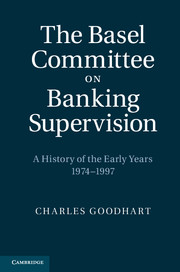Book contents
- Frontmatter
- Contents
- Figures
- Tables
- Foreword
- Preface
- 1 Introduction
- 2 The antecedents of the BCBS
- 3 Modus operandi
- 4 The Concordat
- 5 External and foreign exchange issues
- 6 Capital adequacy and the Basel Accord of 1988
- 7 The Market Risk Amendment
- 8 The Core Principles of Banking Supervision
- 9 Liquidity
- 10 Off-balance-sheet exposures and derivatives
- 11 Other topics addressed by the BCBS
- 12 The relationship of the BCBS with banks and other banking regulators
- 13 Relationships with other non-bank oversight and supervisory bodies
- 14 The legal position of the BCBS
- 15 The international relations of the BCBS
- 16 The BCBS and the social sciences
- 17 Epilogue
- Bibliography
- Index
13 - Relationships with other non-bank oversight and supervisory bodies
Published online by Cambridge University Press: 07 September 2011
- Frontmatter
- Contents
- Figures
- Tables
- Foreword
- Preface
- 1 Introduction
- 2 The antecedents of the BCBS
- 3 Modus operandi
- 4 The Concordat
- 5 External and foreign exchange issues
- 6 Capital adequacy and the Basel Accord of 1988
- 7 The Market Risk Amendment
- 8 The Core Principles of Banking Supervision
- 9 Liquidity
- 10 Off-balance-sheet exposures and derivatives
- 11 Other topics addressed by the BCBS
- 12 The relationship of the BCBS with banks and other banking regulators
- 13 Relationships with other non-bank oversight and supervisory bodies
- 14 The legal position of the BCBS
- 15 The international relations of the BCBS
- 16 The BCBS and the social sciences
- 17 Epilogue
- Bibliography
- Index
Summary
Relationships with other BIS standing committees
The BCBS was not, and is not, an autonomous committee. As has been amply documented in previous chapters, it was established by, got its mandate from and answers to the G10 central bank Governors. While it has always had a certain latitude to initiate work unilaterally, its work programme is reported to the Governors and they can set its priorities. It cannot communicate conclusions, nor make proposals, to bodies outside the BIS without the general agreement and support of the Governors.
The G10 Governors (and the subcommittees that the Governors establish) are serviced and provided with a Secretariat by the BIS. The relationship between the G10 governors and the BIS, under the General Manager, is somewhat intricate, and has been nicely described by Toniolo and Clement in their book Central Bank Cooperation at the Bank for International Settlements, 1930–1973 (2005). The BIS does not control the BCBS in any sense. The BCBS takes its own decisions, subject to the wishes of the G10 governors and subject to the constraints on resources for the Secretariat made available to them by the BIS (normally agreed by consensus, but subject to negotiation between the Committee’s Chairman and the BIS if resolution is needed).
- Type
- Chapter
- Information
- The Basel Committee on Banking SupervisionA History of the Early Years 1974–1997, pp. 465 - 541Publisher: Cambridge University PressPrint publication year: 2011



